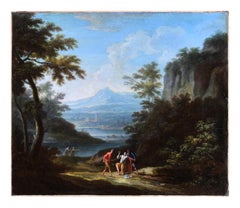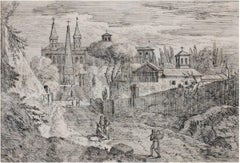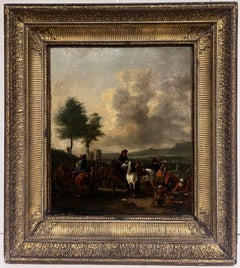18th Century Art
to
4
3
1
1
4
3
5
1
1
Overall Height
to
Overall Width
to
6
7
4
3
2
1
7
7
7
166
128
93
82
4
3
3
2
2
Period: 18th Century
Artist: Jan Frans van Bloemen (Orizzonte)
Wooden Landscape with Shepherds, Fountain and Flock - by Jan Frans van Bloemen
Located in Roma, IT
Bibliography:
A.Busiri Vici, Jan Frans Van Bloemen Orizzonte e l’origine del paesaggio romano settecentesco, Ugo Bozzi Editore, Roma 1974, n.41
This artwork is shipped from Italy. U...
Category
Old Masters 18th Century Art
Materials
Canvas, Oil
Two Arcadic Landscapes - J.F. Van Bloemen (follower of) - Oil on Canvas
Located in Roma, IT
Two Arcadic Landscapes are a couple of original oil paintings by a follower of the Flemish artist, Jan Frans Van Bloemen (1662-1749).
These old master's original paintings represen...
Category
Old Masters 18th Century Art
Materials
Oil
Pair of Roman Landscapes - by J.F. Van Bloemen - 18th Century
Located in Roma, IT
Beautiful couple of Roman Landscape by J. F. Van Bloemen, in very good conditions and with later wooden frames.
Bibliography and Exhibitions:
Old Master Exhibition, H.Terry-Engell, ...
Category
18th Century Art
Materials
Canvas, Oil
"Figures Outside the Monastery, " Original Etching by Jan Frans van Bloemen
Located in Milwaukee, WI
"Figures Outside the Monastery" is an original etching by Jan Frans van Bloemen. It depicts people on the path to a church.
7" x 10 1/4" art
19 1/4" x 22 5/8" frame
Jan Frans van Bloemen (baptized 12 May 1662 - buried 13 June 1749) was a Flemish landscape painter mainly active in Rome. Here he was able to establish himself as the leading painter of views (vedute) of the Roman countryside depicted in the aesthetic of the classical landscape tradition.
Van Bloemen predominantly painted classical landscapes, taking his inspiration from the Roman Campagna. His landscapes, with their recession through a series of planes, soft, warm lightning and classical and religious subject matter, drew on the examples of artists such as Claude Lorrain and Gaspard Dughet. His paintings are exquisitely imbued with that "difficult-to-define pastoral ambience" which helped to make him such a great painter in the eyes of his contemporaries. The technique and subjects of the work of Jan Frans van Bloemen are also related to painters such as Jan Asselijn, Thomas Wyck...
Category
Old Masters 18th Century Art
Materials
Etching
"Figures at the Obelisk, " Original Etching Landscape by Jan Frans van Bloemen
Located in Milwaukee, WI
"Figures at the Obelisk" is an original etching by Jan Frans van Bloemen. It depicts two people conversing in front of a monument. Behind them, an expansive landscape sprawls.
9 1/4" x 6 3/4" art
21 3/4" x 19 3/8" frame
Jan Frans van Bloemen (baptized 12 May 1662 - buried 13 June 1749) was a Flemish landscape painter mainly active in Rome. Here he was able to establish himself as the leading painter of views (vedute) of the Roman countryside depicted in the aesthetic of the classical landscape tradition.
Van Bloemen predominantly painted classical landscapes, taking his inspiration from the Roman Campagna. His landscapes, with their recession through a series of planes, soft, warm lightning and classical and religious subject matter, drew on the examples of artists such as Claude Lorrain and Gaspard Dughet. His paintings are exquisitely imbued with that "difficult-to-define pastoral ambience" which helped to make him such a great painter in the eyes of his contemporaries. The technique and subjects of the work of Jan Frans van Bloemen are also related to painters such as Jan Asselijn, Thomas Wyck...
Category
Old Masters 18th Century Art
Materials
Etching
"Conversation Outside Castle, " an Etching by Jan Frans van Bloemen
Located in Milwaukee, WI
"Conversation Outside Castle" is an original etching by Jan Frans van Bloemen. It depicts a number of figures just outside the majestic walls of a castle. These groups of figures are engaged in their own conversations.
9" x 6 3/4" art
21 5/8" x 19 3/8" frame
Jan Frans van Bloemen (baptized 12 May 1662 - buried 13 June 1749) was a Flemish landscape painter mainly active in Rome. Here he was able to establish himself as the leading painter of views (vedute) of the Roman countryside depicted in the aesthetic of the classical landscape tradition.
Van Bloemen predominantly painted classical landscapes, taking his inspiration from the Roman Campagna. His landscapes, with their recession through a series of planes, soft, warm lightning and classical and religious subject matter, drew on the examples of artists such as Claude Lorrain and Gaspard Dughet. His paintings are exquisitely imbued with that "difficult-to-define pastoral ambience" which helped to make him such a great painter in the eyes of his contemporaries. The technique and subjects of the work of Jan Frans van Bloemen are also related to painters such as Jan Asselijn...
Category
Old Masters 18th Century Art
Materials
Etching
"Mother & Child Near Statues, " Etching by Jan Frans van Bloemen (Orizzonte)
Located in Milwaukee, WI
"Mother & Child Near Statues" is an original etching by Jan Frans van Bloemen. It depicts two figures, a mother and child pair, next two two classical statues. There are other figures in this park-like environment.
9 1/4" x 6 3/4" art
21 5/8" x 19 3/8" frame
Jan Frans van Bloemen (baptized 12 May 1662 - buried 13 June 1749) was a Flemish landscape painter mainly active in Rome. Here he was able to establish himself as the leading painter of views (vedute) of the Roman countryside depicted in the aesthetic of the classical landscape tradition.
Van Bloemen predominantly painted classical landscapes, taking his inspiration from the Roman Campagna. His landscapes, with their recession through a series of planes, soft, warm lightning and classical and religious subject matter, drew on the examples of artists such as Claude Lorrain and Gaspard Dughet. His paintings are exquisitely imbued with that "difficult-to-define pastoral ambience" which helped to make him such a great painter in the eyes of his contemporaries. The technique and subjects of the work of Jan Frans van Bloemen are also related to painters such as Jan Asselijn...
Category
Old Masters 18th Century Art
Materials
Etching
Related Items
Fine 17th Century Dutch Old Master Oil Military Encampment Figures on Horseback
Located in Cirencester, Gloucestershire
The Military Encampment
Dutch School, 17th century
circle of Philips Wouwermans (Dutch 1619-1668)
oil painting on canvas, in 18th century gilt frame
canvas measures: 19.5 x 17 inches...
Category
Old Masters 18th Century Art
Materials
Canvas, Oil
H 27 in W 24 in D 2 in
Suite of 12 Views of Italy
By Franz Weirotter
Located in New York, NY
Franz Weirotter (1730-1771), Suite of 12 Views of Italy, etchings, 1759 [most signed in the plate by Weirotter]. Reference: Nagel 5. 10 printed in pairs on one sheet; one on a small...
Category
Old Masters 18th Century Art
Materials
Etching
Painting en plein air - Impressionist Figure in Landscape Oil by Charles Angrand
By Charles Angrand
Located in Marlow, Buckinghamshire
Signed and dated oil on canvas by French impressionist painter Charles Theophile Angrand. This wonderful and good-sized piece depicts an artist painting "en plain air" in a beautiful...
Category
Impressionist 18th Century Art
Materials
Canvas, Oil
Antique Scottish Highlands Oil Painting Sunset River Landscape with Mountains
Located in Cirencester, Gloucestershire
"Allan Water, Stirling"
by F. E. Jamieson (British 1895-1950)
signed, lower corner
oil painting on canvas, framed
canvas: 16 x 24 inches
framed: 21.5 x 29 inches
Fine quality antiqu...
Category
Victorian 18th Century Art
Materials
Canvas, Oil
A walk in the vegetable garden
Located in THOMERY, FR
This captivating artwork, titled "A Walk in the Vegetable Garden," is a stunning portrayal of a moment frozen in time, inspired by a vegetable garden I visited in Normandy. It unveil...
Category
Impressionist 18th Century Art
Materials
Canvas, Oil
18th Century sporting horse portrait oil painting of a race horse and groom
Located in Moreton-In-Marsh, Gloucestershire
Francis Sartorius
British, (1734-1804)
Bay Hunter & Groom
Oil on canvas, signed
Image size: 24.25 inches x 29.25 inches
Size including frame: 32 inches x 37 inches
A wonderful spor...
Category
Old Masters 18th Century Art
Materials
Oil, Canvas
Fine Early 1800's Italian Oil Roman Buildings in Ancient Landscape
Located in Cirencester, Gloucestershire
Artist/ School: Italian School, early 1800's
Title: Ancient Buildings in Italianate Landscape
Medium: oil painting on board, framed.
framed: 18.25 x 20.75 inches
canvas: 11 x 13.7...
Category
Old Masters 18th Century Art
Materials
Oil
H 18.25 in W 20.75 in
Signed Antique French Impressionist Oil Painting Children Playing in Park
Located in Cirencester, Gloucestershire
In the Park
by Louis Abel-Truchet (French 1857-1918) *see below
signed oil on canvas, unframed
canvas: 16 x 13 inches
provenance: private collection, France
condition: overall good a...
Category
Impressionist 18th Century Art
Materials
Canvas, Oil
19th Century Roman Landscape oil on canvas with Giltwood Frame
Located in Rome, IT
Amaizing 19' century Roman landscape depicting a part of Villa Borghese with Trinità dei Monti.
With a finely carved gilt wood coeval frame.
Measurements with frame cm 65 x78 wit...
Category
Old Masters 18th Century Art
Materials
Oil
English River landscape, with Church and River at Sunset, Abingdon on the Thames
Located in Woodbury, CT
English River landscape, with Church and River at Sunset, Abingdon on the Thames. England
Wonderful scene of Abingdon on the Thames by one of Englands best known landscape painters....
Category
Impressionist 18th Century Art
Materials
Canvas, Oil
Free Shipping
H 19 in W 25 in
Early oil depicting the Great Fire of London
Located in London, GB
The Great Fire of London in September 1666 was one of the greatest disasters in the city’s history. The City, with its wooden houses crowded together in narrow streets, was a natural fire risk, and predictions that London would burn down became a shocking reality. The fire began in a bakery in Pudding Lane, an area near the Thames teeming with warehouses and shops full of flammable materials, such as timber, oil, coal, pitch and turpentine. Inevitably the fire spread rapidly from this area into the City. Our painting depicts the impact of the fire on those who were caught in it and creates a very dramatic impression of what the fire was like. Closer inspection reveals a scene of chaos and panic with people running out of the gates. It shows Cripplegate in the north of the City, with St Giles without Cripplegate to its left, in flames (on the site of the present day Barbican). The painting probably represents the fire on the night of Tuesday 4 September, when four-fifths of the City was burning at once, including St Paul's Cathedral. Old St Paul’s can be seen to the right of the canvas, the medieval church with its thick stone walls, was considered a place of safety, but the building was covered in wooden scaffolding as it was in the midst of being restored by the then little known architect, Christopher Wren and caught fire. Our painting seems to depict a specific moment on the Tuesday night when the lead on St Paul’s caught fire and, as the diarist John Evelyn described: ‘the stones of Paul’s flew like grenades, the melting lead running down the streets in a stream and the very pavements glowing with the firey redness, so as no horse, nor man, was able to tread on them.’
Although the loss of life was minimal, some accounts record only sixteen perished, the magnitude of the property loss was shocking – some four hundred and thirty acres, about eighty per cent of the City proper was destroyed, including over thirteen thousand houses, eighty-nine churches, and fifty-two Guild Halls. Thousands were homeless and financially ruined. The Great Fire, and the subsequent fire of 1676, which destroyed over six hundred houses south of the Thames, changed the appearance of London forever. The one constructive outcome of the Great Fire was that the plague, which had devastated the population of London since 1665, diminished greatly, due to the mass death of the plague-carrying rats in the blaze.
The fire was widely reported in eyewitness accounts, newspapers, letters and diaries. Samuel Pepys recorded climbing the steeple of Barking Church from which he viewed the destroyed City: ‘the saddest sight of desolation that I ever saw.’ There was an official enquiry into the causes of the fire, petitions to the King and Lord Mayor to rebuild, new legislation and building Acts. Naturally, the fire became a dramatic and extremely popular subject for painters and engravers. A group of works relatively closely related to the present picture have been traditionally ascribed to Jan Griffier...
Category
Old Masters 18th Century Art
Materials
Canvas, Oil
Antique battle painter - 17th century figure painting Battle Knight
By Jacques Courtois
Located in Varmo, IT
Jacques Courtois, known as il Borgognone (Saint-Hyppolite 1621 - Rome 1676) circle of - Battaglia.
53 x 80 cm without frame, 73.5 x 97.5 cm with frame.
Antique oil painting on canv...
Category
Old Masters 18th Century Art
Materials
Oil, Canvas






